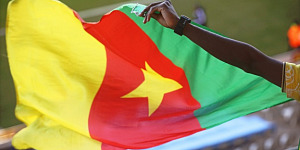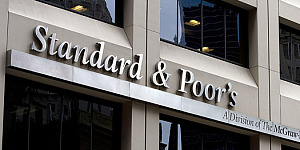On Oct. 23, 2015, Standard & Poor's Ratings Services affirmed its 'B' long-term and 'B' short-term sovereign credit ratings on the Republic of Cameroon. The outlook is stable.
RATIONALE
The ratings reflect our view of Cameroon’s low income per capita, political risk pertaining to presidential succession, and deteriorating fiscal position. All these factors constrain the ratings. Cameroon’s net general government debt remains low, though widening fiscal deficits will trigger a rapid rise. We note that Cameroon's membership of the Central African Economic and Monetary Community (CEMAC) mitigates exchange rate volatility.
In our view, two main risks could undermine Cameroon’s political stability: the uncertainty around the presidential succession process and the rise of the Islamist threat in the North. We expect the president Paul Biya to remain in power until the next presidential election scheduled in late 2018, when he will likely step down. We believe that the country's lack of experience with handovers of power (President Biya has been in office since 1982), its weak institutions, and the population's low confidence in electoral processes could hinder a stable political transition. We note that the constitution has been amended to ensure a smooth presidential succession, but we understand that the institution supposed to recognize the vacancy of the presidency and
subsequently trigger the transition process hasn’t been created yet, hence leaving room for a constitutional void. In the extreme north of the country, threats from the Boko Haram jihadi terrorist group will persist, although we believe risks of critical destabilization will remain contained, notably following the involvement of Chadian troops in the region and expected reinforced cooperation with Nigeria. We also believe that there is a relatively low risk that the ongoing crisis in the neighboring Central African Republic will jeopardize Cameroon's stability.
Despite the large fall in international oil prices and the fragile security and economic situation in the north, Cameroon's economy has grown by 5.9% in 2014. The oil sector represented about 7% of GDP in 2014, and approximately 48% of Cameroon’s exports. We forecast that Cameroon's real GDP growth will average 5.7% in 2015-2018, as the three-year Emergency Plan launched by the government in December 2014 may lead to improved agricultural value chains, development of the energy supply, and buoyant activity in the construction sector.
The government estimates oil output of 35.36 million barrels this year, a 27% increase since 2014. This increase is notably due to the start-up of production of new oil fields, and higher output in existing fields. The government, however, expects oil production to gradually decrease to 24.14 million barrels per year in 2018, due to the main oil fields aging, though we understand that those forecasts exclude any new sources of production and therefore tend to be very conservative.
We anticipate that the potential decrease in oil production, along with lower export prices, will be compensated by further growth in other sectors. Implementation of large road and port infrastructure projects as well as a substantial increase in gas production will continue to drive growth. Natural gas reserves are estimated at 5.4 trillion cubic feet in 2015 and we expect gas production to rise as reserves are increasingly exploited. In 2014, natural gas production surged by 40.5% due to new wells coming into production, as well as improved extraction techniques. We also anticipate that the services sector will remain robust, notably benefiting from investments in transportation, and we expect agriculture production will increase, supported by more-productive seeds and equipment modernization.
Cameroon's fiscal position strongly deteriorated in 2014 to reach a deficit of 5.5% of GDP (up from 4.1% in 2013) and we expect the deficit to remain at around 5.0% in 2015-2018. This reflects strong capital expenditure and lower government oil revenues. In 2014, Cameroon's oil production accounted for about 27% of government revenue (including tax on oil corporations, a special tax on petroleum products, and royalties from crude oil), and slightly less than 50% of the country's exports. The collapse in the oil price will be somewhat offset by one-off revenues from the sale of a mobile telephony
license in 2015, and good tax receipts performance. Low oil prices will also allow for some savings in terms of fuel subsidies, which will partially offset the increase in security and investment outlays. Subsidies the government generally provides to the national refiner, SONARA, to compensate for the difference between the fixed official pump prices and international oil prices, are expected to be 70% lower than initially budgeted this year.
We expect Cameroon's net general government debt to increase significantly over our forecast horizon (2015-2018), reaching 35% of GDP by 2018. This is due to rising deficits and the government's plan to issue a Eurobond this year. We understand the proceeds may be utilized to finance infrastructure and development projects and repay the bridge loan used to fund subsidy arrears to SONARA. We assume the government will issue a $750 million bond, although the amount and timing are not confirmed.
Cameroon's public debt stood at 23% of GDP at year-end 2014, 73% of which is external, and with multi- and bilateral donors (96% of total external debt). This translates into a low interest burden, although the government is increasingly turning to bank lending and capital markets and the high foreign currency component (at an estimated 69% of the total debt at year-end 2014) implies exchange rate risks.
The region's access to capital markets has been reinforced after the regulator enabled banks to use government securities as collateral for repurchase agreements. However, we understand that the recent rise in prudential ratios has somewhat lessened banks' appetites for regional governments' securities. Cameroon's government has large financing needs, which are mounting and could stretch the capacity of the currently shallow regional market.
We expect Cameroon's current account deficits to weaken to 5.2% of GDP in 2015 as oil export receipts fall. Exports will, however, benefit from the economic partnership agreement with the European Union and a modest rise in commodities output, including coffee, cocoa, cotton, aluminum, and timber. We project the deficit will peak at 5.5% of GDP in 2016, as the government starts implementing its ambitious three-year infrastructure program and imports of capital goods and services surge. We expect the deficit will somewhat narrow to 4.8% in 2018, as the country starts exporting gas. We also expect that Cameroon's gross external financing needs will remain large, averaging 96% of current account receipts (CARs) and usable reserves in 2015-2018. We forecast
the country's narrow net external debt will reach an average of 44% of CARs in 2015-2018. The poor quality of external data is likely to remain a rating constraint.
According to our criteria, we assess Cameroon's contingent liabilities as limited. The Ministry of Finance has reported that the government-guaranteed debt of public companies stood at about 6.6% of GDP as of December 2014. We think the country's contingent liabilities from the financial sector are also limited, given the sector's small size relative to GDP, even though some institutions remain fragile.
Cameroon’s monetary flexibility is limited by the CFA franc's peg to the euro, as is the case with any pegged arrangement, and by being part of a broader monetary union. However, the peg also results in inflation rates being generally similar to those of the eurozone, which are low for Africa. We equalize our long-term local and foreign currency ratings on Cameroon because monetary policy, which could underpin a sovereign's greater flexibility in its own currency, is essentially set by CEMAC's regional central bank. Our assessment of Cameroon's transfer and convertibility at 'BBB-', the same as for all CEMAC members, reflects our view of the risk that the central bank
will restrict non-sovereign entities' access to foreign exchange needed to service debt.
OUTLOOK
The stable outlook reflects our expectation that, over the next 12 months, economic growth will remain steady, while Cameroon's institutions will remain weak, and higher fiscal and external deficits will not change significantly from our current assumptions.
We could raise the ratings if our view of Cameroon's institutions improved, namely if the country were to manage a successful and stable political transition. We could also raise the ratings if Cameroon's economic growth and fiscal position outperformed our base-case expectations.
Conversely, we could lower the ratings if the government's liquidity tightened, fiscal or external deficits widened, or debt service increased beyond our current forecasts.






































